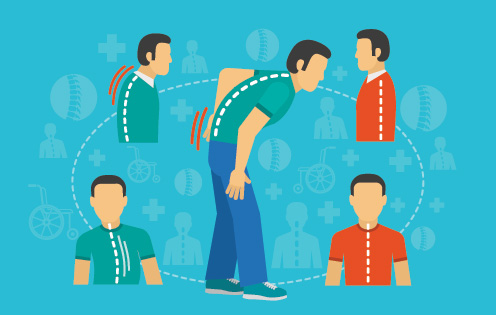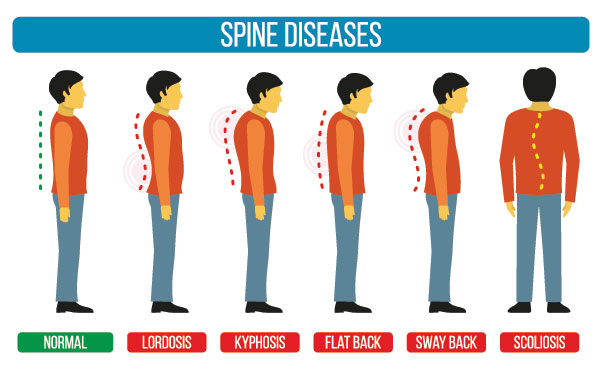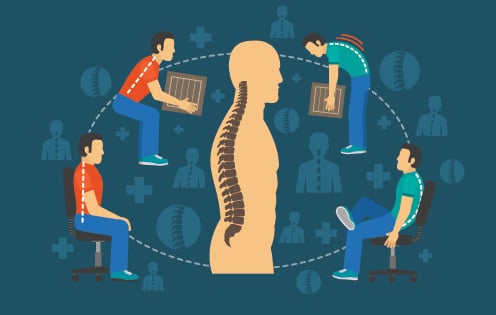The spine is a strand of vertebrae that runs from the skull to the lower back, encasing the spinal cord and providing stability and support to the thoracic cavity. Unfortunately, the spine is also considered by experts to be one of the most abused parts of the body. Maintaining good spine health is not only important for the prevention of chronic pain, but can also help individuals participate in their activities of daily living with ease. A healthy spine is essential for individuals who hope to avoid the use of canes, walkers, and wheelchairs, as it provides significant amounts of stability and support to the pelvis and lower extremities.
POOR POSTURE
Poor posture is most commonly associated with the development of moderate to severe amounts of back pain. In addition, poor posture can lead to the weakening on the lower back and abdominal muscles, which can negatively impact one’s ability to maintain his or her balance and perform daily tasks. Finally, poor posture can also lead to neck pain and headaches, and may even cause nerve impingement of the arms of lower extremities. While there are a number of factors that can lead to the development of poor posture, slouching while seated at a desk is one of the primary culprits.

Unfortunately, humans were not designed to sit in a chair with their arms extended in front of their bodies for an extended period of time. When this does occurs, it can cause the shoulders to round forward, stretching the muscles of the upper back and leading to the significant amounts of back pain described previously. Often, individuals who sit in this position for an extended period of time may develop the habit even when away from the desk—leading to chronically poor posture. Sleeping on a mattress that is overly soft and does not adequately support the body can also lead to the development of poor posture..
SPINAL CURVATURE
In addition to chronic back pain, poor posture can also lead to spinal curvature and subluxation. These conditions can, in turn, lead to spinal nerve damage and potential impingement, which in some cases may be irreversible. In the long term, poor posture can lead to immobility and possible disability. Individuals who suffer from chronically poor posture are also at risk for the development of depression, which often occurs as a result of being unable to perform previous tasks and activities of daily living. Unfortunately, this lack of daily movement can lead to weight gain and obesity, potentially further exacerbating the underlying condition.

IMPROVEMENT TECHNIQUES
While there are a number of techniques that have been found to be effective at improving posture, regular exercise has been found to be especially important. Traditionally, individuals who hope to improve poor posture through exercise are encouraged to focus on exercises that strengthen the muscles of the upper back and shoulders. In addition, relaxing the muscles of the chest and anterior shoulders through stretching can improve flexibility and aid in the management of poor posture. Certain yoga exercises may also be an effective way for individuals who are unfamiliar with traditional stretching regimens to improve their flexibility. While some people may feel that they do not have enough time to exercise, this could not be further from the truth.

EXERCISE
All people have time for some exercise, which is essential at preventing poor posture and the health effects listed above. Individuals who sit at a desk all day—such as business men and women—can get a quick chest stretch by lacing their fingers together behind their back and squeezing their shoulder blades together for a few seconds. In contrast, those who stand on their feet—like waiters, waitresses, and salespeople—can often achieve relief by bending forward and reaching for their toes. Individuals who are interested in learning more about exercises that can fit within their employment and lifestyle limitations should consult with a physical therapist or exercise physiologist for more information.
MORE RESOURCES
- Back Pain–Part 3: Devastating Effects of Long-Term Poor Posture
- Ten Tips for Improving Posture and Ergonomics
- 7 Myths About Bad Posture, Dispelled
- Home Theater Ergonomics: Ergonomics in Theater Room Design
- Slouching….So Wrong bit it Feels So Right
- Health and Fitness: Exercises for Better Posture
- Health and Behavior: Five Ways to Improve Your Posture
- Sit up Straight. Your Back Thanks You
- Harvard Medical School: Posture and back health
- Correct Sitting Position & Therapeutic Excercise(PDF)
- The Importance of Good Posture
- CNN: Yes, sitting too long can kill you, even if you exercise
- Cornell University: The Perils of Sitting & Standing at Work
- The Alexander Technique: Pilot Study
- Posture for a Healthy Back: What is Good Posture?
- Clothing that Improves Posture and Eases Neck, Shoulder, and Back Pain
Home Theater Seating
- Home Media Room Seating
- Leather Theater Seating
- Home Theater Sofa
- Reclining Theater Seats
- Theatre Seats
- Home Theater Seats For Sale
- Best Buy Theatre Seating
- Palliser Home Theater Seating
- Narrow Recliners
- Movie Room Furniture
- Raised Platform For Sofa
- Theater Sofas Clearance
- Best Media Room Sectionals
- Leather Chair Cupholder
- New Sectional Couch
Decor & Accessories
- Lighted Poster Frame
- Theater Room Carpet
- Home Theater Ceiling
- Media Room Decor
- Man Cave Movie Theater
- Popcorn Machines for Sale
- Home Theater Wall Panels
- Home Theatre Decor
- Riser Platform
- Butt Kickers
- Movie Theater Lights
- Black Leather Power Reclining Sofa
- Octane Pillow
- Couch With Heat Massage
- Red Sectional Living Room Ideas
Top Pages
- Theater Seat Store Near Me
- Ashley Recliners
- Cheap Recliners for Sale
- Fabric Couch
- Theater Chairs with Cup Holders
- Modern Design Recliners
- Home Theater Store
- Theater Recliner Seats
- Movie Theater Seats
- Theater Chaise
- Lane Home Theater Seating
- Media Room Sectional Recliner
- Larger Person Easy Chair
- Black Fabric Recliner Chair
- Chaise Sectional Couch

